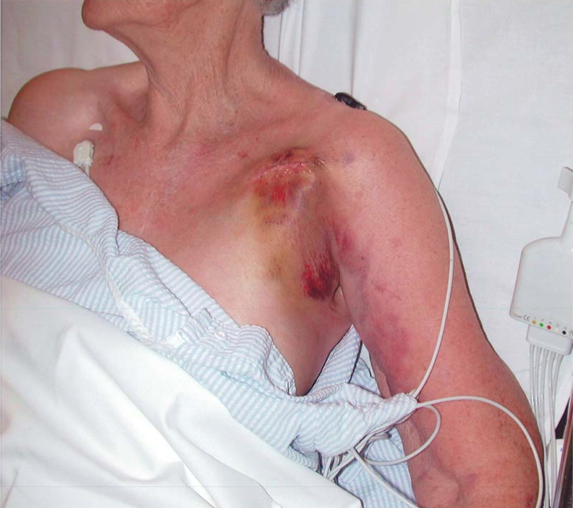MODULE 5: VASCULAR EMERGENCIES
watch
|
|
|
read
The notes below cover dissections and aneurysms, and are a good framework on which to build knowledge. For iPad users a file is below for you to use.
| thoracic-dissection-and-aaa.pdf |
A Summary from the website- THE MIMIC
|
Aortic dissection
A 70 plus year old non-English speaking gentleman presented to the emergency department with chest pain. He was a happy looking gentleman in no apparent distress, but looked very, very pale. He in fact had a ‘pre-arrest’ look about him regardless of the fact that he is smiling. He was treated with sublingual GTN for his chest pain and had a systolic BP of 90mmHg. His ECG was normal. His CXR was as below: So the working diagnosis is…aortic dissection.
On CT angio he had a Stanford Type A+B. The mortality is cumulative and is about 2% per hour. Here are a few points that we raised at the Cardiac Course for this year. With all chest pain patients remember to think of 4 diagnoses. These are the ones to exclude: 1 Acute Myocardial Infarction 2 Pulmonary Embolism 3 Thoracic Aortic Dissection 4 Pneumothorax Risk factors for dissection include: age, genetics, hypertension, coagulopathy and many more. There are several key points to remember: KEY POINT 1 - The patient with dissection can look exceptionally well. KEY POINT 2 - The classic description of tearing central chest pain going through to the back doesn’t always occur. Remember to think of dissection under the following circumstances: |
If there’s one study to read, it’s the IRAD study JAMA 2000; 286:897-903. They found that:
-Abrupt onset of pain occurrs in about 85% of cases -90% of patients call it severe or the worst ever -It can be in the anterior/posterior chest, back or abdomen and it can migrate around as the dissection increases -About 50% of patients are hypertensive -Aortic Insufficiency murmur occurs in about 30% -There is a widened mediastinum on chest Xray in about 60% -The aortic contour is abnormal in about 50% -There is some abnormality on chest Xray in about 88% of cases The patient can present with pain, peripheral artery dissection or malperfusion syndrome. Malperfusion manifests as stroke, renal failure, leg weakness, bowel ischaemia and myocardial infarction. KEY POINT 3 - Be suspicious of aortic dissection if there are symptoms above and below the diaphragm and if there is chest pain PLUS neurological/vascular symptoms. KEY POINT 4 - The D-Dimer is NOT supported as a rule-out test just yet. KEY POINT 5 - The most important way to diagnose aortic dissection is to think of it. In terms of treatment, the main aim is to decrease shear forces and there are two means of achieving this: 1 Decrease heart rate 2 Decrease blood pressure In the hypotensive emergencies lecture at the cardiac course, we discussed means of achieving this. Use a beta blocker- metoprolol 5mgIV in 3 doses or labetolol 20-80mg q10min, or even esmolol if you wish. To lower the blood pressure IV nitroprusside infusion is preferred, but most people will use GTN infusion as they are more familiar with this. In this patient we put up a GTN infusion, for when the sublingual GTN wore off, and as his heart rate was about 70, we did not start a beta blocker at that time. He was admitted under vascular for an endoluminal stent. |
BMJ also has a good review of the aetiology, clinical symptoms, immediate management and disposition of ischaemic limbs. Click on the image of the article to follow the link (opens in a new window).
The resus.com.au blog has a nice review of carotid artery dissection discussing the issue of investigation. The icon below will take you there (opens in a new window).
solve
The question below is yet another VAQ from the old exam. Do the exercises below as you answer the question. The main learning point is to try to gain some insight into what thought processes you should be developing for the exam.
An 80 year old man presents with pain in his right axilla and arm four days after the elective insertion of a permanent pacemaker.
His vital signs are:
BP 160/80mmHg
RR 24 /min
Sats 98% RA
T 37.8 degrees.
Describe and interpret her photograph.
His vital signs are:
BP 160/80mmHg
RR 24 /min
Sats 98% RA
T 37.8 degrees.
Describe and interpret her photograph.
Now, before you have a go at answering do two things.
1. Write down the most likely diagnosis (before you describe and interpret).
2. Write down three questions you think need to be answered as part of the VAQ and answer them.
1. Write down the most likely diagnosis (before you describe and interpret).
2. Write down three questions you think need to be answered as part of the VAQ and answer them.
WRITE.
Write 3 MCQs in vascular surgery as well as one vascular SAQ with at least 2 subquestions and an explanation of each. As usual please put them up on the VSG.



